Sales Management: Training Workbook and Financial Analysis Report
VerifiedAdded on 2019/09/24
|15
|3060
|165
Report
AI Summary
This report presents a comprehensive analysis of sales management principles, encompassing a training workbook and financial analysis. The training workbook delves into crucial concepts such as customer lifetime value, target profitability, and potential variable costs, providing a practical guide for sales team members. The financial analysis section assesses accounting procedures, customer account profit statements, business and financial risks, and the value of each customer. It also includes a review of financial performance, identifying key trends and variances, and outlines business decisions based on financial data. Furthermore, the report addresses contingency plans and communication strategies to ensure access to financial performance data, offering a holistic view of sales management practices.
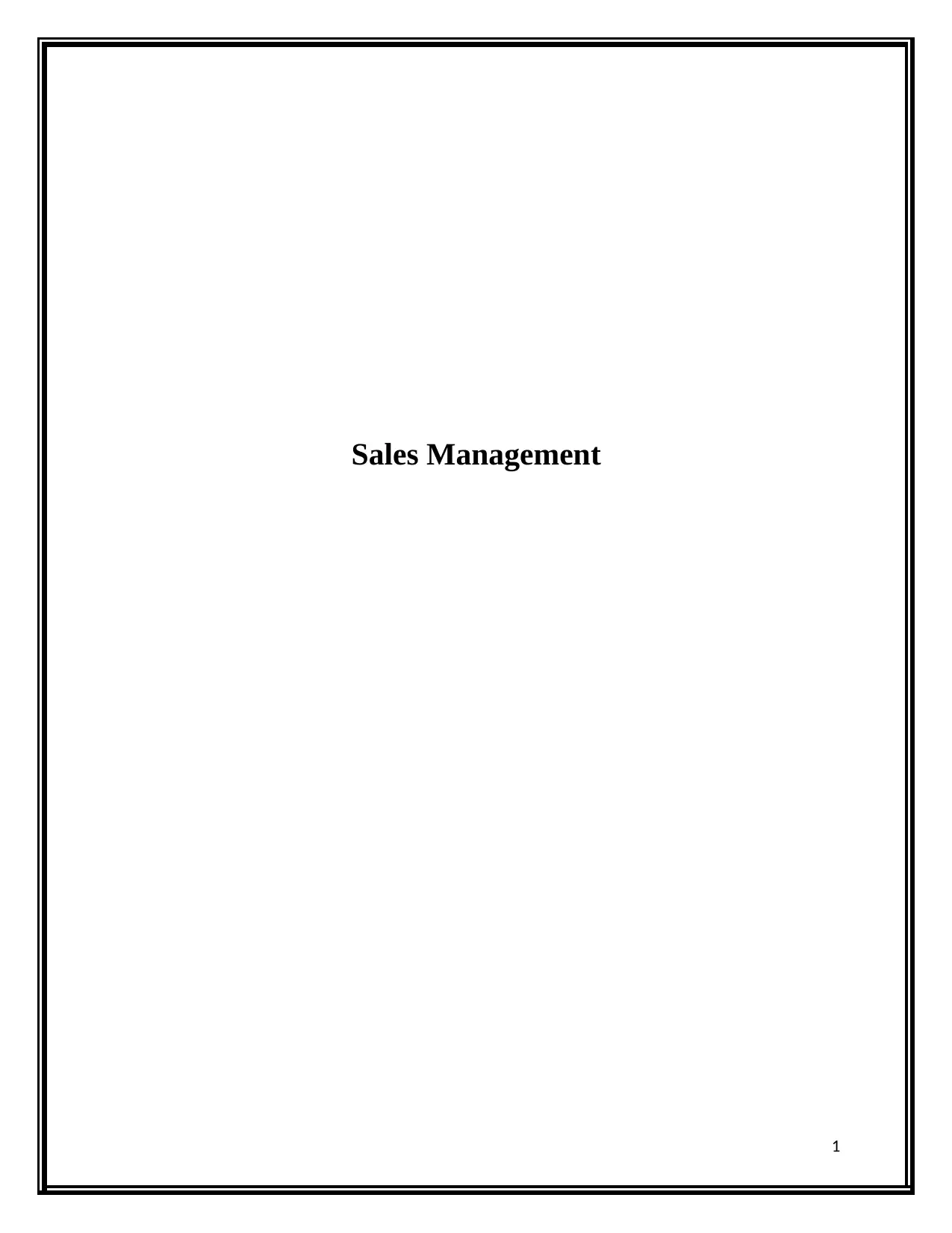
Sales Management
1
1
Paraphrase This Document
Need a fresh take? Get an instant paraphrase of this document with our AI Paraphraser
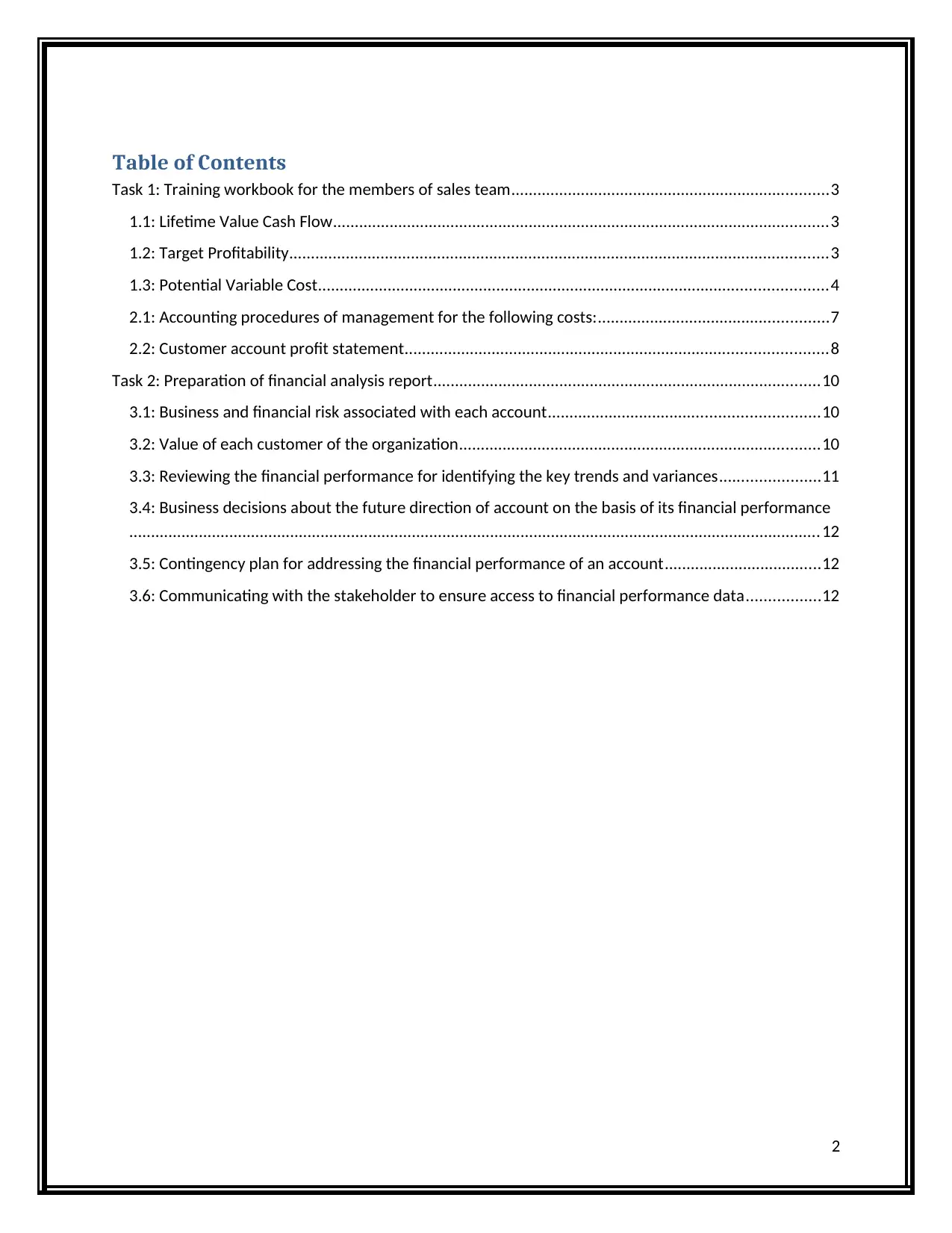
Table of Contents
Task 1: Training workbook for the members of sales team.........................................................................3
1.1: Lifetime Value Cash Flow..................................................................................................................3
1.2: Target Profitability............................................................................................................................3
1.3: Potential Variable Cost.....................................................................................................................4
2.1: Accounting procedures of management for the following costs:.....................................................7
2.2: Customer account profit statement.................................................................................................8
Task 2: Preparation of financial analysis report.........................................................................................10
3.1: Business and financial risk associated with each account..............................................................10
3.2: Value of each customer of the organization...................................................................................10
3.3: Reviewing the financial performance for identifying the key trends and variances.......................11
3.4: Business decisions about the future direction of account on the basis of its financial performance
...............................................................................................................................................................12
3.5: Contingency plan for addressing the financial performance of an account....................................12
3.6: Communicating with the stakeholder to ensure access to financial performance data.................12
2
Task 1: Training workbook for the members of sales team.........................................................................3
1.1: Lifetime Value Cash Flow..................................................................................................................3
1.2: Target Profitability............................................................................................................................3
1.3: Potential Variable Cost.....................................................................................................................4
2.1: Accounting procedures of management for the following costs:.....................................................7
2.2: Customer account profit statement.................................................................................................8
Task 2: Preparation of financial analysis report.........................................................................................10
3.1: Business and financial risk associated with each account..............................................................10
3.2: Value of each customer of the organization...................................................................................10
3.3: Reviewing the financial performance for identifying the key trends and variances.......................11
3.4: Business decisions about the future direction of account on the basis of its financial performance
...............................................................................................................................................................12
3.5: Contingency plan for addressing the financial performance of an account....................................12
3.6: Communicating with the stakeholder to ensure access to financial performance data.................12
2
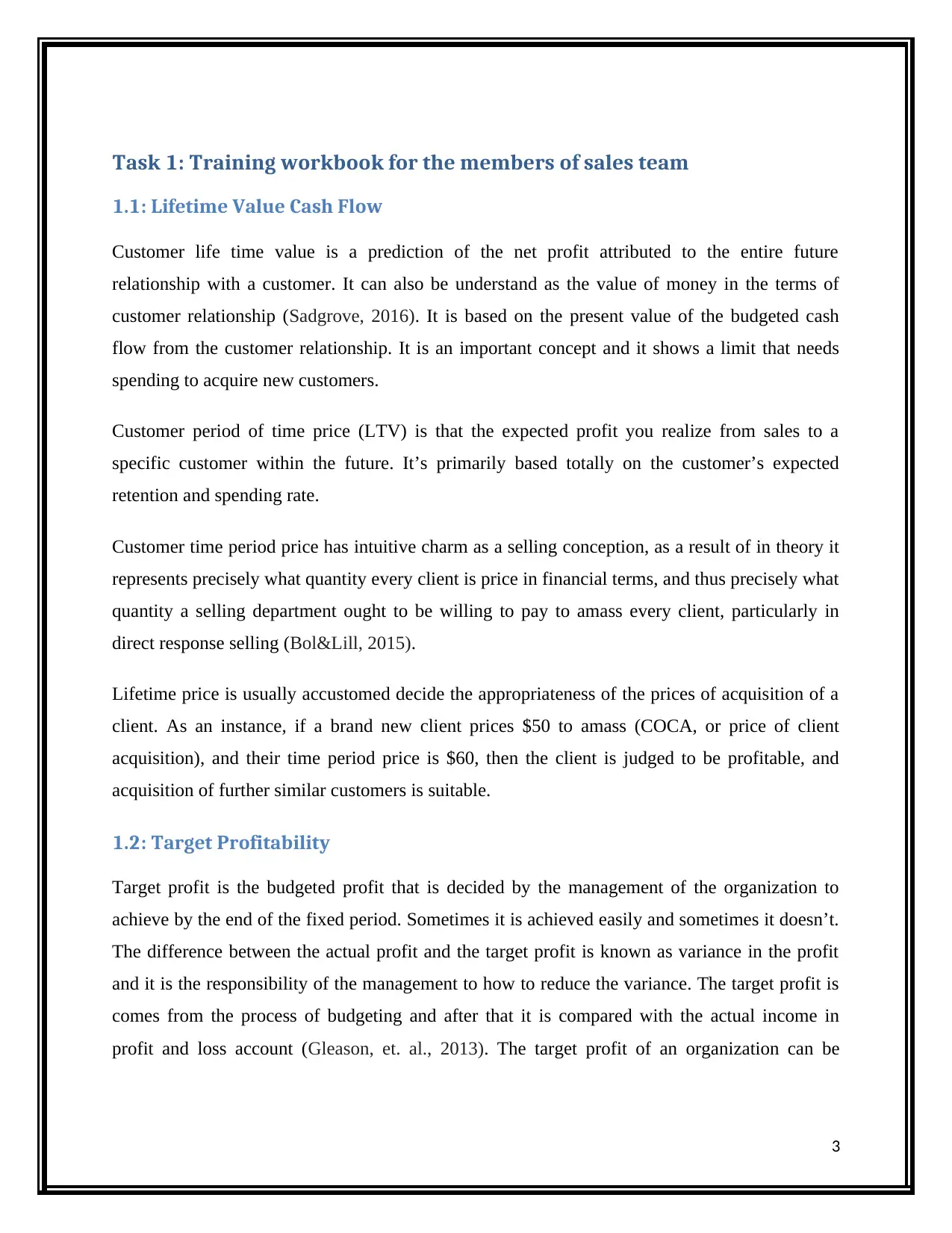
Task 1: Training workbook for the members of sales team
1.1: Lifetime Value Cash Flow
Customer life time value is a prediction of the net profit attributed to the entire future
relationship with a customer. It can also be understand as the value of money in the terms of
customer relationship (Sadgrove, 2016). It is based on the present value of the budgeted cash
flow from the customer relationship. It is an important concept and it shows a limit that needs
spending to acquire new customers.
Customer period of time price (LTV) is that the expected profit you realize from sales to a
specific customer within the future. It’s primarily based totally on the customer’s expected
retention and spending rate.
Customer time period price has intuitive charm as a selling conception, as a result of in theory it
represents precisely what quantity every client is price in financial terms, and thus precisely what
quantity a selling department ought to be willing to pay to amass every client, particularly in
direct response selling (Bol&Lill, 2015).
Lifetime price is usually accustomed decide the appropriateness of the prices of acquisition of a
client. As an instance, if a brand new client prices $50 to amass (COCA, or price of client
acquisition), and their time period price is $60, then the client is judged to be profitable, and
acquisition of further similar customers is suitable.
1.2: Target Profitability
Target profit is the budgeted profit that is decided by the management of the organization to
achieve by the end of the fixed period. Sometimes it is achieved easily and sometimes it doesn’t.
The difference between the actual profit and the target profit is known as variance in the profit
and it is the responsibility of the management to how to reduce the variance. The target profit is
comes from the process of budgeting and after that it is compared with the actual income in
profit and loss account (Gleason, et. al., 2013). The target profit of an organization can be
3
1.1: Lifetime Value Cash Flow
Customer life time value is a prediction of the net profit attributed to the entire future
relationship with a customer. It can also be understand as the value of money in the terms of
customer relationship (Sadgrove, 2016). It is based on the present value of the budgeted cash
flow from the customer relationship. It is an important concept and it shows a limit that needs
spending to acquire new customers.
Customer period of time price (LTV) is that the expected profit you realize from sales to a
specific customer within the future. It’s primarily based totally on the customer’s expected
retention and spending rate.
Customer time period price has intuitive charm as a selling conception, as a result of in theory it
represents precisely what quantity every client is price in financial terms, and thus precisely what
quantity a selling department ought to be willing to pay to amass every client, particularly in
direct response selling (Bol&Lill, 2015).
Lifetime price is usually accustomed decide the appropriateness of the prices of acquisition of a
client. As an instance, if a brand new client prices $50 to amass (COCA, or price of client
acquisition), and their time period price is $60, then the client is judged to be profitable, and
acquisition of further similar customers is suitable.
1.2: Target Profitability
Target profit is the budgeted profit that is decided by the management of the organization to
achieve by the end of the fixed period. Sometimes it is achieved easily and sometimes it doesn’t.
The difference between the actual profit and the target profit is known as variance in the profit
and it is the responsibility of the management to how to reduce the variance. The target profit is
comes from the process of budgeting and after that it is compared with the actual income in
profit and loss account (Gleason, et. al., 2013). The target profit of an organization can be
3
⊘ This is a preview!⊘
Do you want full access?
Subscribe today to unlock all pages.

Trusted by 1+ million students worldwide
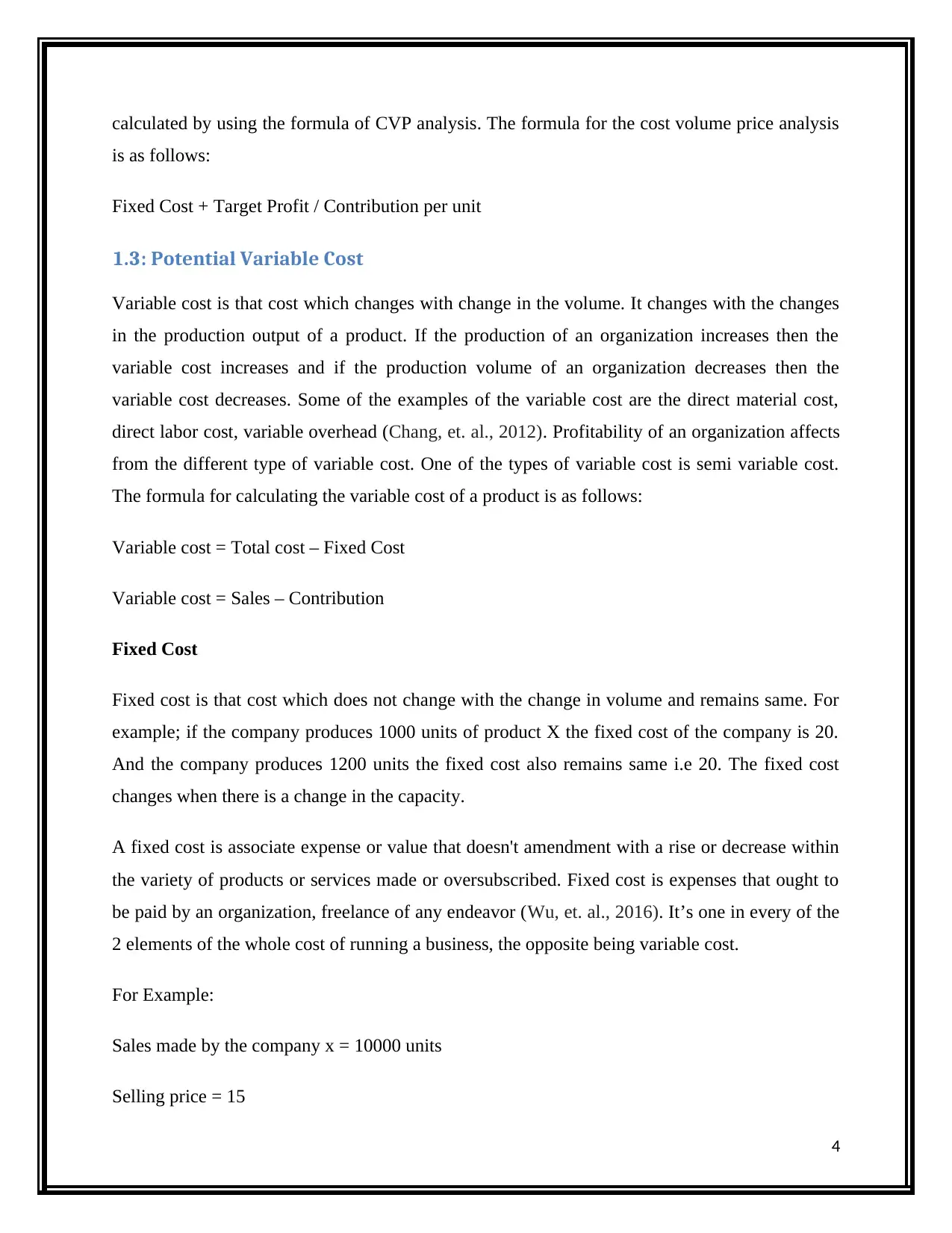
calculated by using the formula of CVP analysis. The formula for the cost volume price analysis
is as follows:
Fixed Cost + Target Profit / Contribution per unit
1.3: Potential Variable Cost
Variable cost is that cost which changes with change in the volume. It changes with the changes
in the production output of a product. If the production of an organization increases then the
variable cost increases and if the production volume of an organization decreases then the
variable cost decreases. Some of the examples of the variable cost are the direct material cost,
direct labor cost, variable overhead (Chang, et. al., 2012). Profitability of an organization affects
from the different type of variable cost. One of the types of variable cost is semi variable cost.
The formula for calculating the variable cost of a product is as follows:
Variable cost = Total cost – Fixed Cost
Variable cost = Sales – Contribution
Fixed Cost
Fixed cost is that cost which does not change with the change in volume and remains same. For
example; if the company produces 1000 units of product X the fixed cost of the company is 20.
And the company produces 1200 units the fixed cost also remains same i.e 20. The fixed cost
changes when there is a change in the capacity.
A fixed cost is associate expense or value that doesn't amendment with a rise or decrease within
the variety of products or services made or oversubscribed. Fixed cost is expenses that ought to
be paid by an organization, freelance of any endeavor (Wu, et. al., 2016). It’s one in every of the
2 elements of the whole cost of running a business, the opposite being variable cost.
For Example:
Sales made by the company x = 10000 units
Selling price = 15
4
is as follows:
Fixed Cost + Target Profit / Contribution per unit
1.3: Potential Variable Cost
Variable cost is that cost which changes with change in the volume. It changes with the changes
in the production output of a product. If the production of an organization increases then the
variable cost increases and if the production volume of an organization decreases then the
variable cost decreases. Some of the examples of the variable cost are the direct material cost,
direct labor cost, variable overhead (Chang, et. al., 2012). Profitability of an organization affects
from the different type of variable cost. One of the types of variable cost is semi variable cost.
The formula for calculating the variable cost of a product is as follows:
Variable cost = Total cost – Fixed Cost
Variable cost = Sales – Contribution
Fixed Cost
Fixed cost is that cost which does not change with the change in volume and remains same. For
example; if the company produces 1000 units of product X the fixed cost of the company is 20.
And the company produces 1200 units the fixed cost also remains same i.e 20. The fixed cost
changes when there is a change in the capacity.
A fixed cost is associate expense or value that doesn't amendment with a rise or decrease within
the variety of products or services made or oversubscribed. Fixed cost is expenses that ought to
be paid by an organization, freelance of any endeavor (Wu, et. al., 2016). It’s one in every of the
2 elements of the whole cost of running a business, the opposite being variable cost.
For Example:
Sales made by the company x = 10000 units
Selling price = 15
4
Paraphrase This Document
Need a fresh take? Get an instant paraphrase of this document with our AI Paraphraser
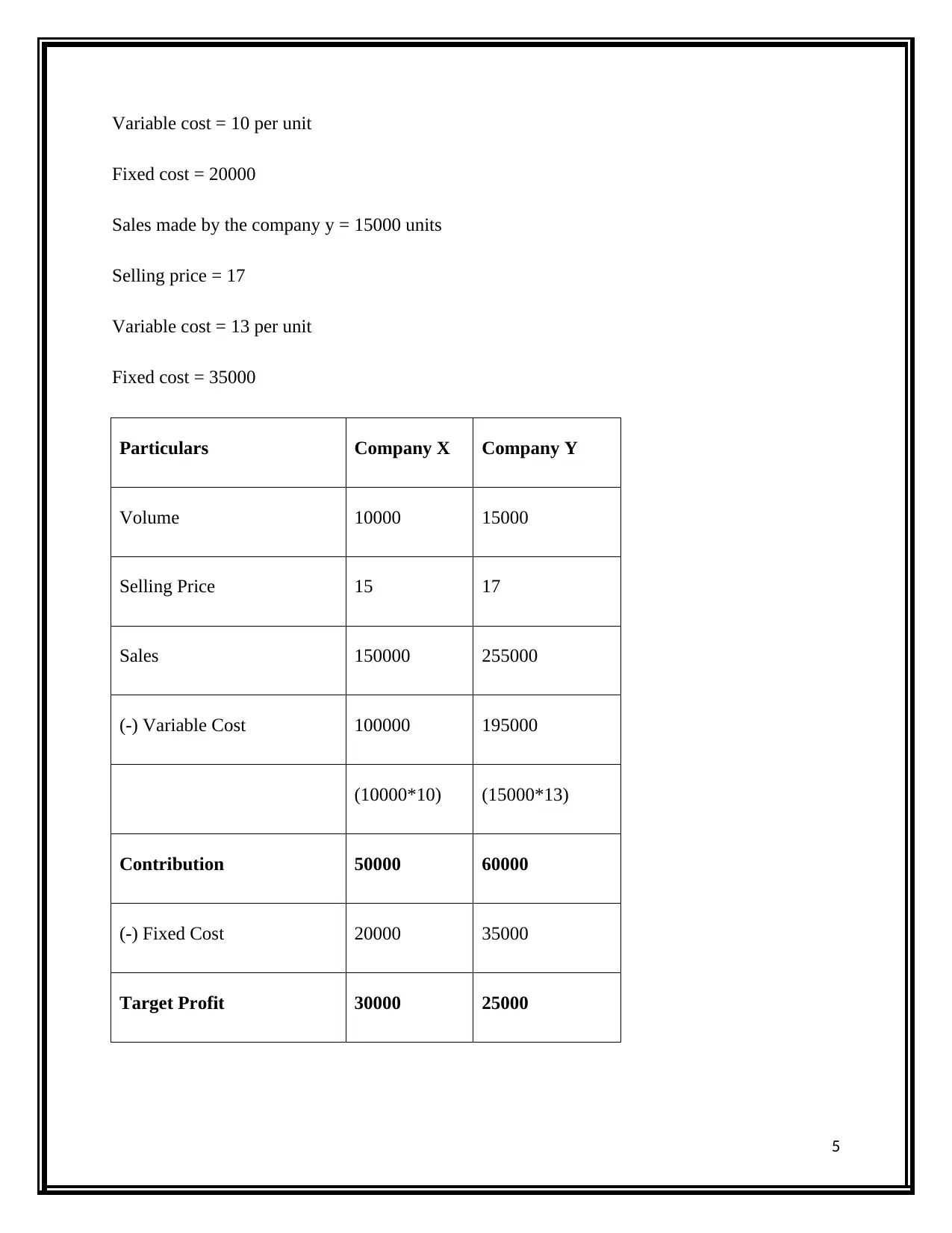
Variable cost = 10 per unit
Fixed cost = 20000
Sales made by the company y = 15000 units
Selling price = 17
Variable cost = 13 per unit
Fixed cost = 35000
Particulars Company X Company Y
Volume 10000 15000
Selling Price 15 17
Sales 150000 255000
(-) Variable Cost 100000 195000
(10000*10) (15000*13)
Contribution 50000 60000
(-) Fixed Cost 20000 35000
Target Profit 30000 25000
5
Fixed cost = 20000
Sales made by the company y = 15000 units
Selling price = 17
Variable cost = 13 per unit
Fixed cost = 35000
Particulars Company X Company Y
Volume 10000 15000
Selling Price 15 17
Sales 150000 255000
(-) Variable Cost 100000 195000
(10000*10) (15000*13)
Contribution 50000 60000
(-) Fixed Cost 20000 35000
Target Profit 30000 25000
5
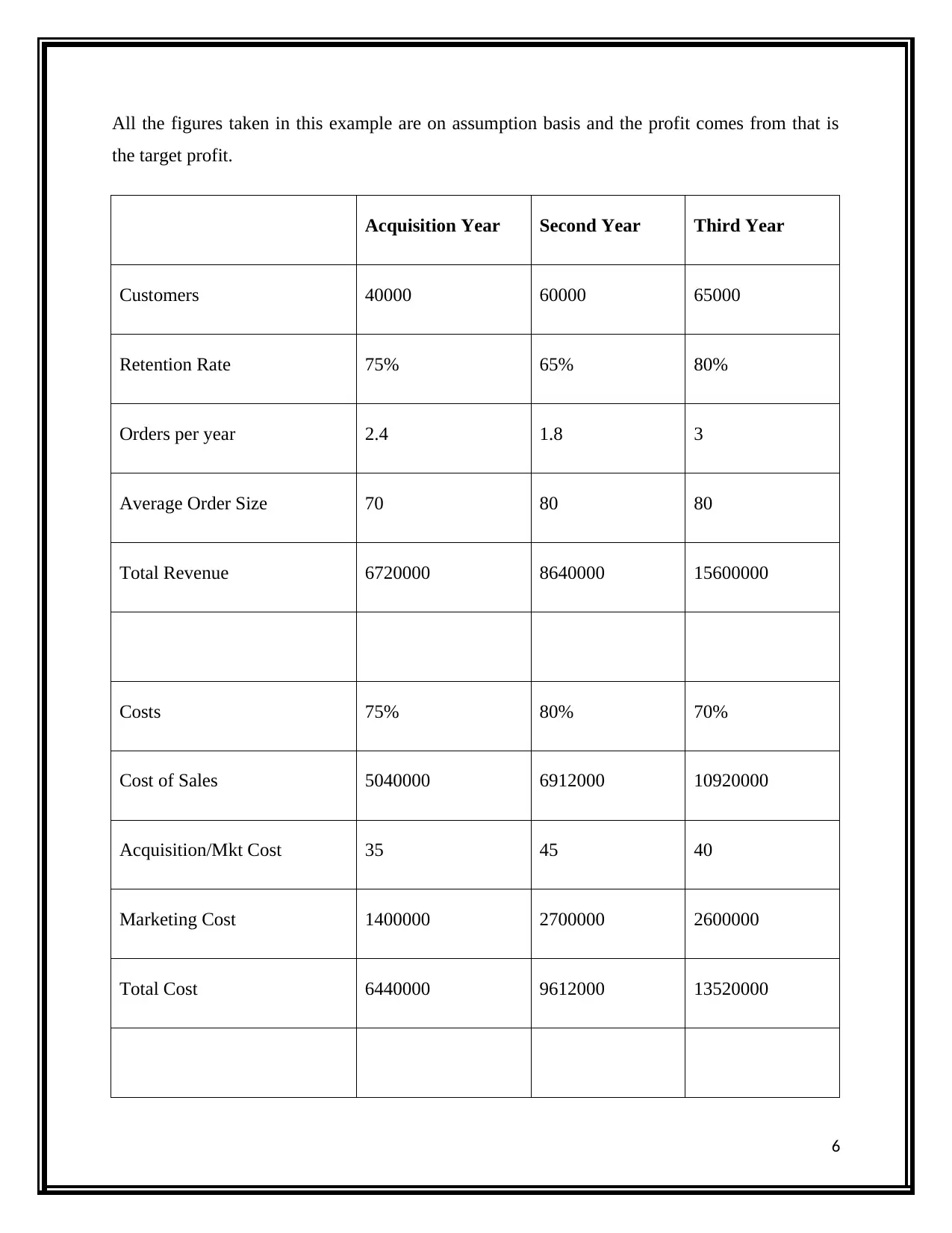
All the figures taken in this example are on assumption basis and the profit comes from that is
the target profit.
Acquisition Year Second Year Third Year
Customers 40000 60000 65000
Retention Rate 75% 65% 80%
Orders per year 2.4 1.8 3
Average Order Size 70 80 80
Total Revenue 6720000 8640000 15600000
Costs 75% 80% 70%
Cost of Sales 5040000 6912000 10920000
Acquisition/Mkt Cost 35 45 40
Marketing Cost 1400000 2700000 2600000
Total Cost 6440000 9612000 13520000
6
the target profit.
Acquisition Year Second Year Third Year
Customers 40000 60000 65000
Retention Rate 75% 65% 80%
Orders per year 2.4 1.8 3
Average Order Size 70 80 80
Total Revenue 6720000 8640000 15600000
Costs 75% 80% 70%
Cost of Sales 5040000 6912000 10920000
Acquisition/Mkt Cost 35 45 40
Marketing Cost 1400000 2700000 2600000
Total Cost 6440000 9612000 13520000
6
⊘ This is a preview!⊘
Do you want full access?
Subscribe today to unlock all pages.

Trusted by 1+ million students worldwide
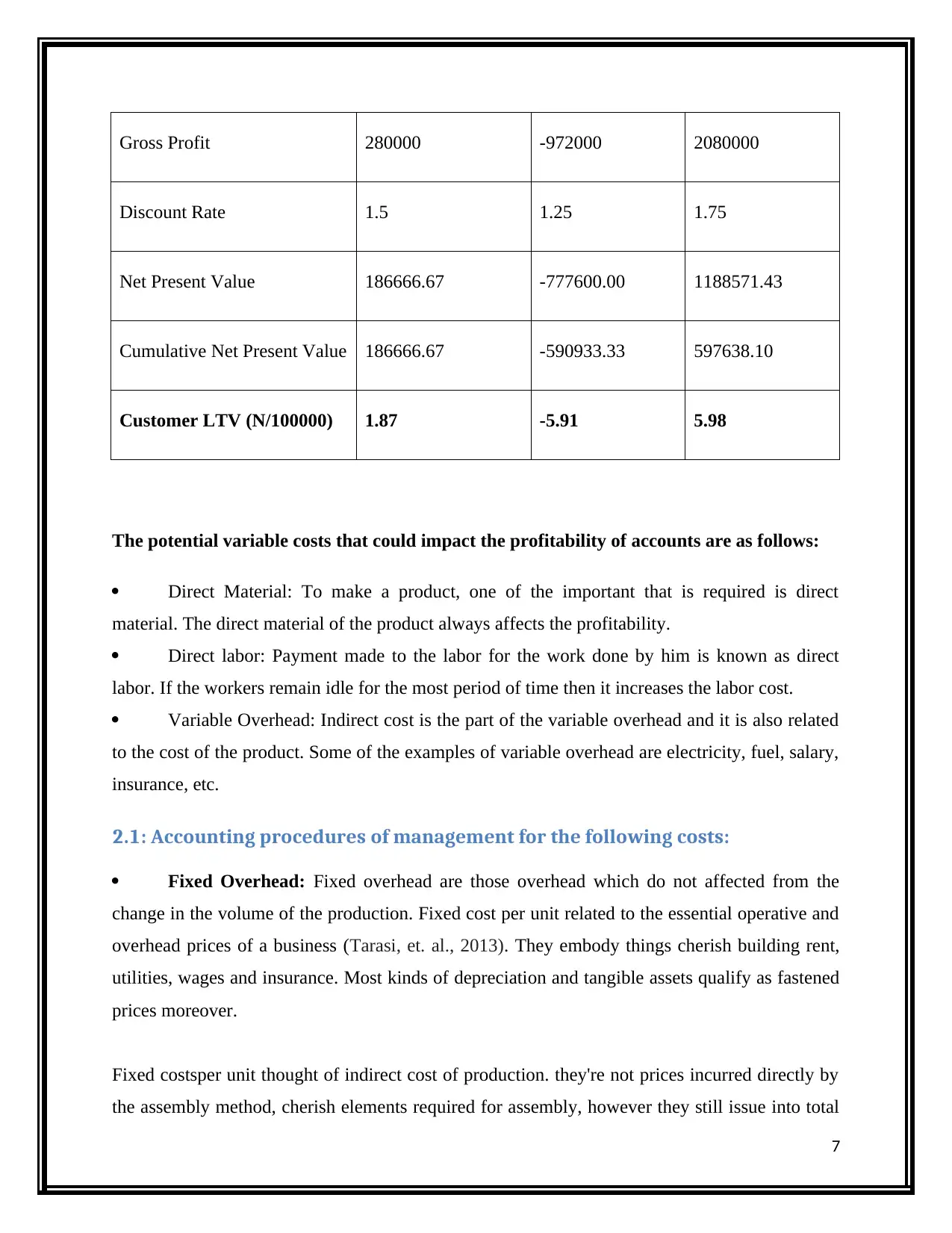
Gross Profit 280000 -972000 2080000
Discount Rate 1.5 1.25 1.75
Net Present Value 186666.67 -777600.00 1188571.43
Cumulative Net Present Value 186666.67 -590933.33 597638.10
Customer LTV (N/100000) 1.87 -5.91 5.98
The potential variable costs that could impact the profitability of accounts are as follows:
Direct Material: To make a product, one of the important that is required is direct
material. The direct material of the product always affects the profitability.
Direct labor: Payment made to the labor for the work done by him is known as direct
labor. If the workers remain idle for the most period of time then it increases the labor cost.
Variable Overhead: Indirect cost is the part of the variable overhead and it is also related
to the cost of the product. Some of the examples of variable overhead are electricity, fuel, salary,
insurance, etc.
2.1: Accounting procedures of management for the following costs:
Fixed Overhead: Fixed overhead are those overhead which do not affected from the
change in the volume of the production. Fixed cost per unit related to the essential operative and
overhead prices of a business (Tarasi, et. al., 2013). They embody things cherish building rent,
utilities, wages and insurance. Most kinds of depreciation and tangible assets qualify as fastened
prices moreover.
Fixed costsper unit thought of indirect cost of production. they're not prices incurred directly by
the assembly method, cherish elements required for assembly, however they still issue into total
7
Discount Rate 1.5 1.25 1.75
Net Present Value 186666.67 -777600.00 1188571.43
Cumulative Net Present Value 186666.67 -590933.33 597638.10
Customer LTV (N/100000) 1.87 -5.91 5.98
The potential variable costs that could impact the profitability of accounts are as follows:
Direct Material: To make a product, one of the important that is required is direct
material. The direct material of the product always affects the profitability.
Direct labor: Payment made to the labor for the work done by him is known as direct
labor. If the workers remain idle for the most period of time then it increases the labor cost.
Variable Overhead: Indirect cost is the part of the variable overhead and it is also related
to the cost of the product. Some of the examples of variable overhead are electricity, fuel, salary,
insurance, etc.
2.1: Accounting procedures of management for the following costs:
Fixed Overhead: Fixed overhead are those overhead which do not affected from the
change in the volume of the production. Fixed cost per unit related to the essential operative and
overhead prices of a business (Tarasi, et. al., 2013). They embody things cherish building rent,
utilities, wages and insurance. Most kinds of depreciation and tangible assets qualify as fastened
prices moreover.
Fixed costsper unit thought of indirect cost of production. they're not prices incurred directly by
the assembly method, cherish elements required for assembly, however they still issue into total
7
Paraphrase This Document
Need a fresh take? Get an instant paraphrase of this document with our AI Paraphraser
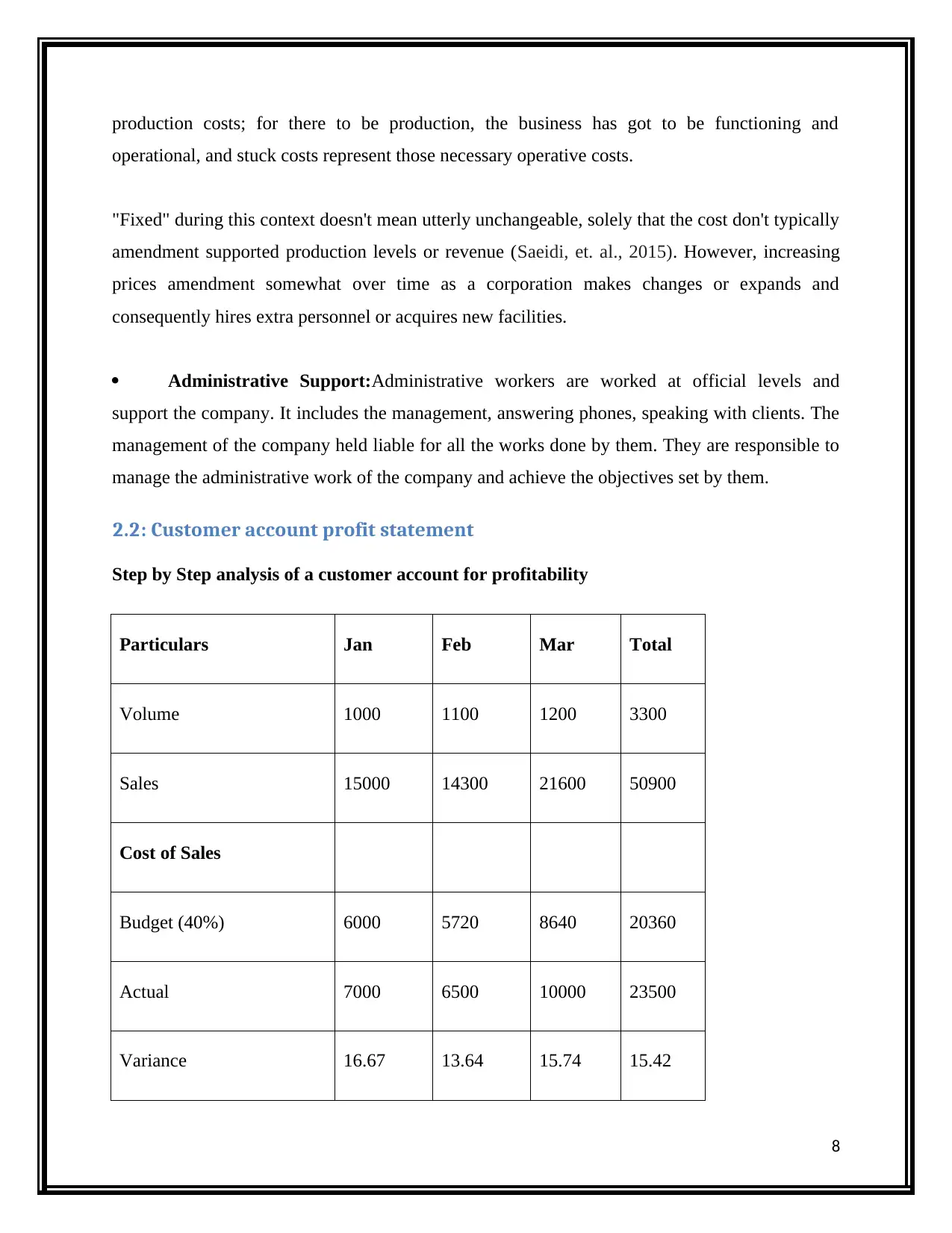
production costs; for there to be production, the business has got to be functioning and
operational, and stuck costs represent those necessary operative costs.
"Fixed" during this context doesn't mean utterly unchangeable, solely that the cost don't typically
amendment supported production levels or revenue (Saeidi, et. al., 2015). However, increasing
prices amendment somewhat over time as a corporation makes changes or expands and
consequently hires extra personnel or acquires new facilities.
Administrative Support:Administrative workers are worked at official levels and
support the company. It includes the management, answering phones, speaking with clients. The
management of the company held liable for all the works done by them. They are responsible to
manage the administrative work of the company and achieve the objectives set by them.
2.2: Customer account profit statement
Step by Step analysis of a customer account for profitability
Particulars Jan Feb Mar Total
Volume 1000 1100 1200 3300
Sales 15000 14300 21600 50900
Cost of Sales
Budget (40%) 6000 5720 8640 20360
Actual 7000 6500 10000 23500
Variance 16.67 13.64 15.74 15.42
8
operational, and stuck costs represent those necessary operative costs.
"Fixed" during this context doesn't mean utterly unchangeable, solely that the cost don't typically
amendment supported production levels or revenue (Saeidi, et. al., 2015). However, increasing
prices amendment somewhat over time as a corporation makes changes or expands and
consequently hires extra personnel or acquires new facilities.
Administrative Support:Administrative workers are worked at official levels and
support the company. It includes the management, answering phones, speaking with clients. The
management of the company held liable for all the works done by them. They are responsible to
manage the administrative work of the company and achieve the objectives set by them.
2.2: Customer account profit statement
Step by Step analysis of a customer account for profitability
Particulars Jan Feb Mar Total
Volume 1000 1100 1200 3300
Sales 15000 14300 21600 50900
Cost of Sales
Budget (40%) 6000 5720 8640 20360
Actual 7000 6500 10000 23500
Variance 16.67 13.64 15.74 15.42
8
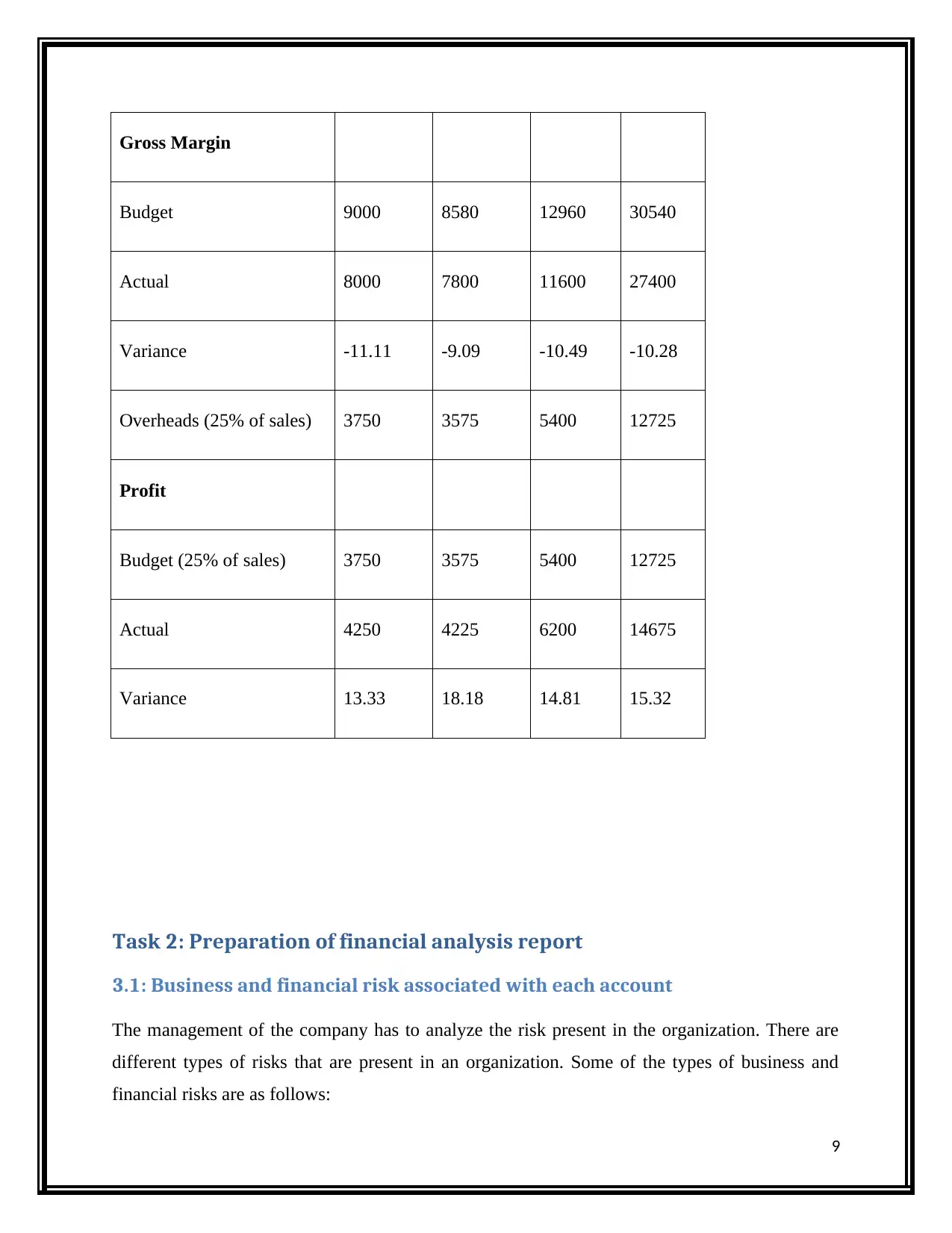
Gross Margin
Budget 9000 8580 12960 30540
Actual 8000 7800 11600 27400
Variance -11.11 -9.09 -10.49 -10.28
Overheads (25% of sales) 3750 3575 5400 12725
Profit
Budget (25% of sales) 3750 3575 5400 12725
Actual 4250 4225 6200 14675
Variance 13.33 18.18 14.81 15.32
Task 2: Preparation of financial analysis report
3.1: Business and financial risk associated with each account
The management of the company has to analyze the risk present in the organization. There are
different types of risks that are present in an organization. Some of the types of business and
financial risks are as follows:
9
Budget 9000 8580 12960 30540
Actual 8000 7800 11600 27400
Variance -11.11 -9.09 -10.49 -10.28
Overheads (25% of sales) 3750 3575 5400 12725
Profit
Budget (25% of sales) 3750 3575 5400 12725
Actual 4250 4225 6200 14675
Variance 13.33 18.18 14.81 15.32
Task 2: Preparation of financial analysis report
3.1: Business and financial risk associated with each account
The management of the company has to analyze the risk present in the organization. There are
different types of risks that are present in an organization. Some of the types of business and
financial risks are as follows:
9
⊘ This is a preview!⊘
Do you want full access?
Subscribe today to unlock all pages.

Trusted by 1+ million students worldwide

Credit Risk: Credit risk is that risk that is associated with the credit sales made by the
company. To increase the sales, every company has to sell their product on credit basis. There
are always the chances of bad debts. If the financial position of a customer is a bad then credit
risk in this case increases.
Profitability of Sales: Profit on sales always contains the risk. If the sales made by the
company is high then the chances of the profit increases but if the sales of the goods decreases
then the profit of the company also decreases.
Fixed Cost Investments: If the prices of the investments fall then the value of the assets of
an organization also decreases and this increases the financial risk.
Legal Risks: If the company has any contingent liability then there is a chance of
payment of that liability and because of that there is always the chance of legal risk (Best, 2012).
Availability of Raw Material: Every company has to maintain the minimum stock in the
case of emergency and this creates the risk of shortage of material in the future.
3.2: Value of each customer of the organization
The customer focused organization is 60% profitable in comparison to the non-customer focused
organizations. The customer focused organization provides too much focus on the features of the
product and the features of their product attract the customers to buy more. The customer
focused organizations has more focus on the quality of the product. Customer satisfaction is what
they seek. If the customer in an organization is new customer then the management gives less
focus on them. The value of old customer is more as they are connected with the company for a
long time and their loyalty is matter to the company. The customer that is connected with the
company beyond three years will receive some special benefits from the company in comparison
to the other customer (Yu,et. al., 2013). The organization has gained their trust and because of
that if they increase the price of the product in the future there will be less problem. The old
customer will purchase the product on high price as he thinks the product sold by the company is
good.
Recommendations to increase the customers of an organization
Customer want value, not products:Very low percentage of people chooses the product
because of the vendor. Large range of customers wants value from the organization.
10
company. To increase the sales, every company has to sell their product on credit basis. There
are always the chances of bad debts. If the financial position of a customer is a bad then credit
risk in this case increases.
Profitability of Sales: Profit on sales always contains the risk. If the sales made by the
company is high then the chances of the profit increases but if the sales of the goods decreases
then the profit of the company also decreases.
Fixed Cost Investments: If the prices of the investments fall then the value of the assets of
an organization also decreases and this increases the financial risk.
Legal Risks: If the company has any contingent liability then there is a chance of
payment of that liability and because of that there is always the chance of legal risk (Best, 2012).
Availability of Raw Material: Every company has to maintain the minimum stock in the
case of emergency and this creates the risk of shortage of material in the future.
3.2: Value of each customer of the organization
The customer focused organization is 60% profitable in comparison to the non-customer focused
organizations. The customer focused organization provides too much focus on the features of the
product and the features of their product attract the customers to buy more. The customer
focused organizations has more focus on the quality of the product. Customer satisfaction is what
they seek. If the customer in an organization is new customer then the management gives less
focus on them. The value of old customer is more as they are connected with the company for a
long time and their loyalty is matter to the company. The customer that is connected with the
company beyond three years will receive some special benefits from the company in comparison
to the other customer (Yu,et. al., 2013). The organization has gained their trust and because of
that if they increase the price of the product in the future there will be less problem. The old
customer will purchase the product on high price as he thinks the product sold by the company is
good.
Recommendations to increase the customers of an organization
Customer want value, not products:Very low percentage of people chooses the product
because of the vendor. Large range of customers wants value from the organization.
10
Paraphrase This Document
Need a fresh take? Get an instant paraphrase of this document with our AI Paraphraser
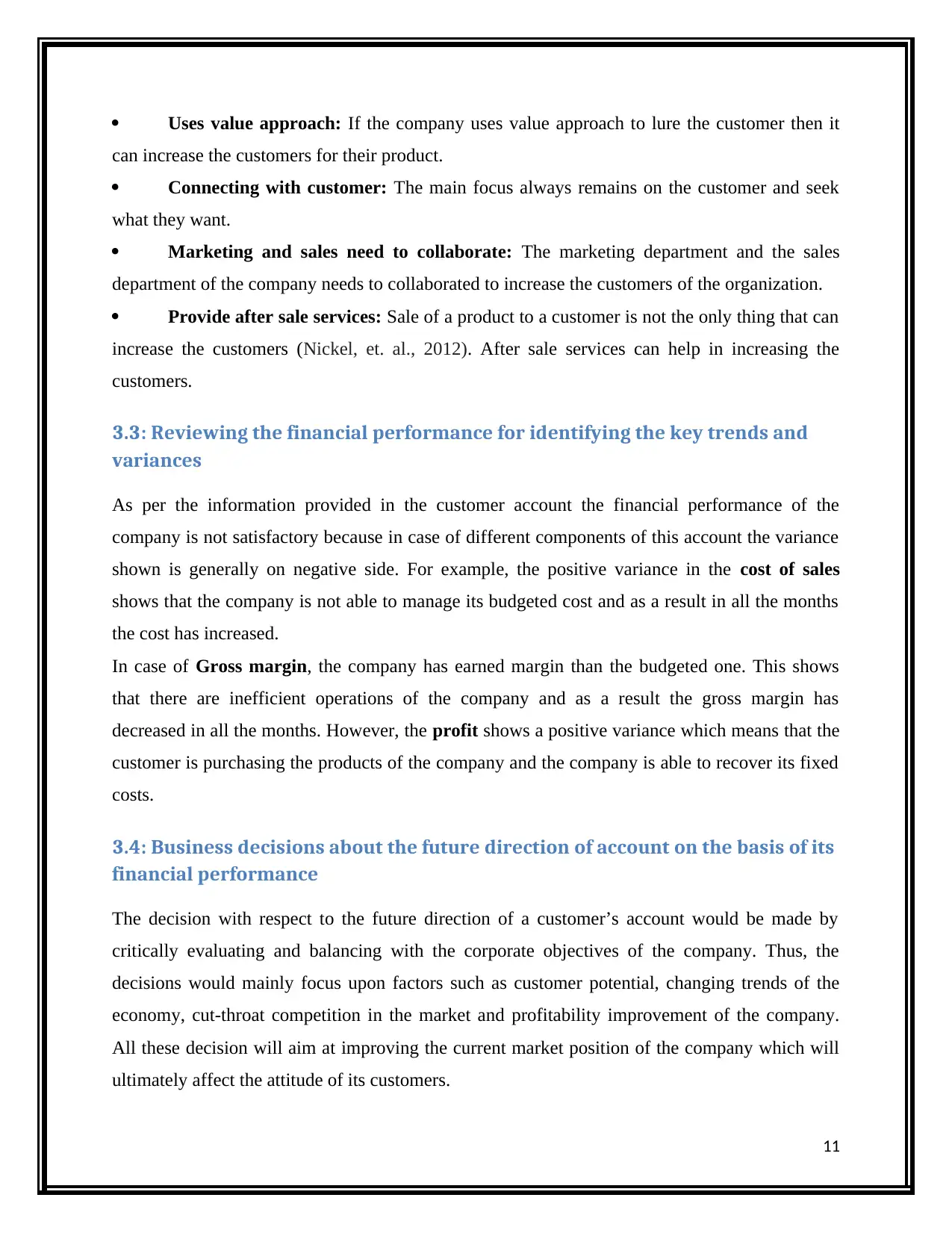
Uses value approach: If the company uses value approach to lure the customer then it
can increase the customers for their product.
Connecting with customer: The main focus always remains on the customer and seek
what they want.
Marketing and sales need to collaborate: The marketing department and the sales
department of the company needs to collaborated to increase the customers of the organization.
Provide after sale services: Sale of a product to a customer is not the only thing that can
increase the customers (Nickel, et. al., 2012). After sale services can help in increasing the
customers.
3.3: Reviewing the financial performance for identifying the key trends and
variances
As per the information provided in the customer account the financial performance of the
company is not satisfactory because in case of different components of this account the variance
shown is generally on negative side. For example, the positive variance in the cost of sales
shows that the company is not able to manage its budgeted cost and as a result in all the months
the cost has increased.
In case of Gross margin, the company has earned margin than the budgeted one. This shows
that there are inefficient operations of the company and as a result the gross margin has
decreased in all the months. However, the profit shows a positive variance which means that the
customer is purchasing the products of the company and the company is able to recover its fixed
costs.
3.4: Business decisions about the future direction of account on the basis of its
financial performance
The decision with respect to the future direction of a customer’s account would be made by
critically evaluating and balancing with the corporate objectives of the company. Thus, the
decisions would mainly focus upon factors such as customer potential, changing trends of the
economy, cut-throat competition in the market and profitability improvement of the company.
All these decision will aim at improving the current market position of the company which will
ultimately affect the attitude of its customers.
11
can increase the customers for their product.
Connecting with customer: The main focus always remains on the customer and seek
what they want.
Marketing and sales need to collaborate: The marketing department and the sales
department of the company needs to collaborated to increase the customers of the organization.
Provide after sale services: Sale of a product to a customer is not the only thing that can
increase the customers (Nickel, et. al., 2012). After sale services can help in increasing the
customers.
3.3: Reviewing the financial performance for identifying the key trends and
variances
As per the information provided in the customer account the financial performance of the
company is not satisfactory because in case of different components of this account the variance
shown is generally on negative side. For example, the positive variance in the cost of sales
shows that the company is not able to manage its budgeted cost and as a result in all the months
the cost has increased.
In case of Gross margin, the company has earned margin than the budgeted one. This shows
that there are inefficient operations of the company and as a result the gross margin has
decreased in all the months. However, the profit shows a positive variance which means that the
customer is purchasing the products of the company and the company is able to recover its fixed
costs.
3.4: Business decisions about the future direction of account on the basis of its
financial performance
The decision with respect to the future direction of a customer’s account would be made by
critically evaluating and balancing with the corporate objectives of the company. Thus, the
decisions would mainly focus upon factors such as customer potential, changing trends of the
economy, cut-throat competition in the market and profitability improvement of the company.
All these decision will aim at improving the current market position of the company which will
ultimately affect the attitude of its customers.
11
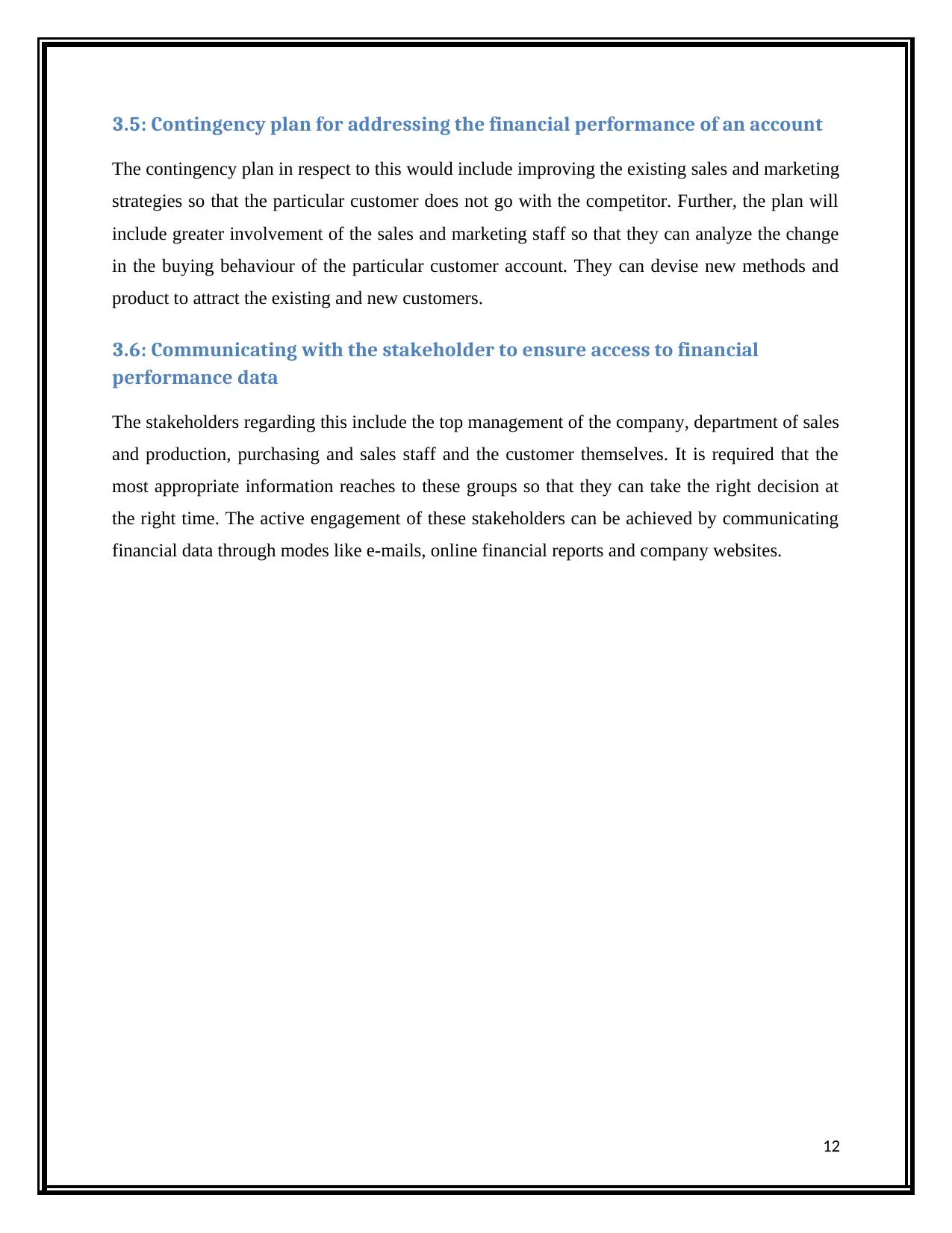
3.5: Contingency plan for addressing the financial performance of an account
The contingency plan in respect to this would include improving the existing sales and marketing
strategies so that the particular customer does not go with the competitor. Further, the plan will
include greater involvement of the sales and marketing staff so that they can analyze the change
in the buying behaviour of the particular customer account. They can devise new methods and
product to attract the existing and new customers.
3.6: Communicating with the stakeholder to ensure access to financial
performance data
The stakeholders regarding this include the top management of the company, department of sales
and production, purchasing and sales staff and the customer themselves. It is required that the
most appropriate information reaches to these groups so that they can take the right decision at
the right time. The active engagement of these stakeholders can be achieved by communicating
financial data through modes like e-mails, online financial reports and company websites.
12
The contingency plan in respect to this would include improving the existing sales and marketing
strategies so that the particular customer does not go with the competitor. Further, the plan will
include greater involvement of the sales and marketing staff so that they can analyze the change
in the buying behaviour of the particular customer account. They can devise new methods and
product to attract the existing and new customers.
3.6: Communicating with the stakeholder to ensure access to financial
performance data
The stakeholders regarding this include the top management of the company, department of sales
and production, purchasing and sales staff and the customer themselves. It is required that the
most appropriate information reaches to these groups so that they can take the right decision at
the right time. The active engagement of these stakeholders can be achieved by communicating
financial data through modes like e-mails, online financial reports and company websites.
12
⊘ This is a preview!⊘
Do you want full access?
Subscribe today to unlock all pages.

Trusted by 1+ million students worldwide
1 out of 15
Related Documents
Your All-in-One AI-Powered Toolkit for Academic Success.
+13062052269
info@desklib.com
Available 24*7 on WhatsApp / Email
![[object Object]](/_next/static/media/star-bottom.7253800d.svg)
Unlock your academic potential
Copyright © 2020–2025 A2Z Services. All Rights Reserved. Developed and managed by ZUCOL.





